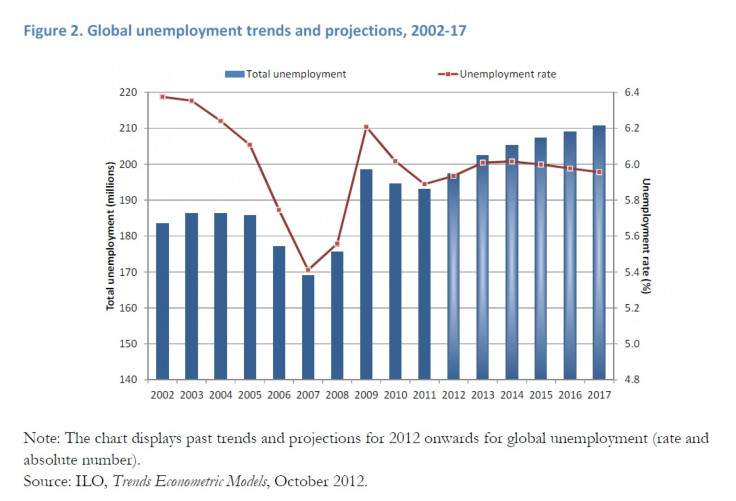Global Unemployment To Hit Record High In 2013: ILO

Global unemployment could top record levels in 2013 and continue rising until 2017, a new report by the United Nations labor agency warned Tuesday, adding that the labor market situation remains particularly bleak for the world’s youth.
In its annual employment report, the International Labour Organization (ILO) said the number of jobless people around the world rose by 4 million last year to 197 million. It is expected to rise by 5.1 million this year to reach 203 million. That will top 2009’s record, when 198 million people were without work.
The report predicts that even with an acceleration of growth, the global unemployment rate is expected to remain at 6 percent up to 2017, not far from its peak level in 2009. At the same time, the number of jobseekers is expected to rise to more than 210 million over the next five years.
In addition, the ILO is recording rising numbers of people who choose not to search for jobs because they think the situation is hopeless.

“An uncertain economic outlook, and the inadequacy of policy to counter this, has weakened aggregate demand, holding back investment and hiring,” said ILO Director-General Guy Ryder in a statement. “This has prolonged the labor market slump in many countries, lowering job creation and increasing unemployment duration even in some countries that previously had low unemployment and dynamic labor markets.”
“Also, many of the new jobs require skills that jobseekers do not have,” he added. “Governments should step up efforts to support skills and retraining activities in order to address such mismatches which particularly affect young people.”
While the crisis may have originated in the developed world, the report noted that three-quarters of last year’s newly unemployed came from outside it, with East Asia, South Asia and Sub-Saharan Africa being the worst affected.
In particular, the report singles out the impact of the global unemployment crisis on the world’s youth.
Currently, nearly 74 million people in the 15-to-24 age group are unemployed globally and the slowdown in economic activity is likely to push another half-million into unemployment by 2014, according to the ILO.
Of particular concern is the fact that more and more young people experience long-term unemployment right from the start of their labor market entry, a situation that was never observed during earlier cyclical downturns.
Some 35 percent of unemployed youth in advanced economies have been out of a job for six months or longer. As a consequence, increasing numbers of young people are getting discouraged and leaving the labor market.
The past five years saw a drop of about 2 percentage points in global youth labor force participation rate. There were about 23 million fewer employed youth in 2012 than in 2007, despite growth in the global youth population of more than 12 million, the report said.
Experiencing long spells of unemployment or dropping out from the labor market early on in the career erodes professional and social skills and prevents young people from gaining on-the-job experience.
In effect, many youth in a number of countries risk going from being unemployed or out of the labor market to becoming unemployable.
New jobs that become available often require competences that “the unemployed do not possess,” the report said. “Such skill and occupational mismatches will make the labor market react more slowly to any acceleration in activity over the medium run, unless supporting policies to re-skill and activate current job-seekers are enhanced.”
The U.N. official pointed out that regional differences in youth unemployment were likely to be marked, with the situation expected to improve slightly over the next five years in the developed economies while emerging economies in Eastern Europe, East and South-East Asia and the Middle East would continue to see rising joblessness among its young labor force.
Watch: Uncertainty Holds Back Job Creation
Ekkehard Ernst, Chief of the ILO Employment Trends Unit talks about what can be done to help restore confidence and encourage job creation, especially for young people.
© Copyright IBTimes 2024. All rights reserved.






















